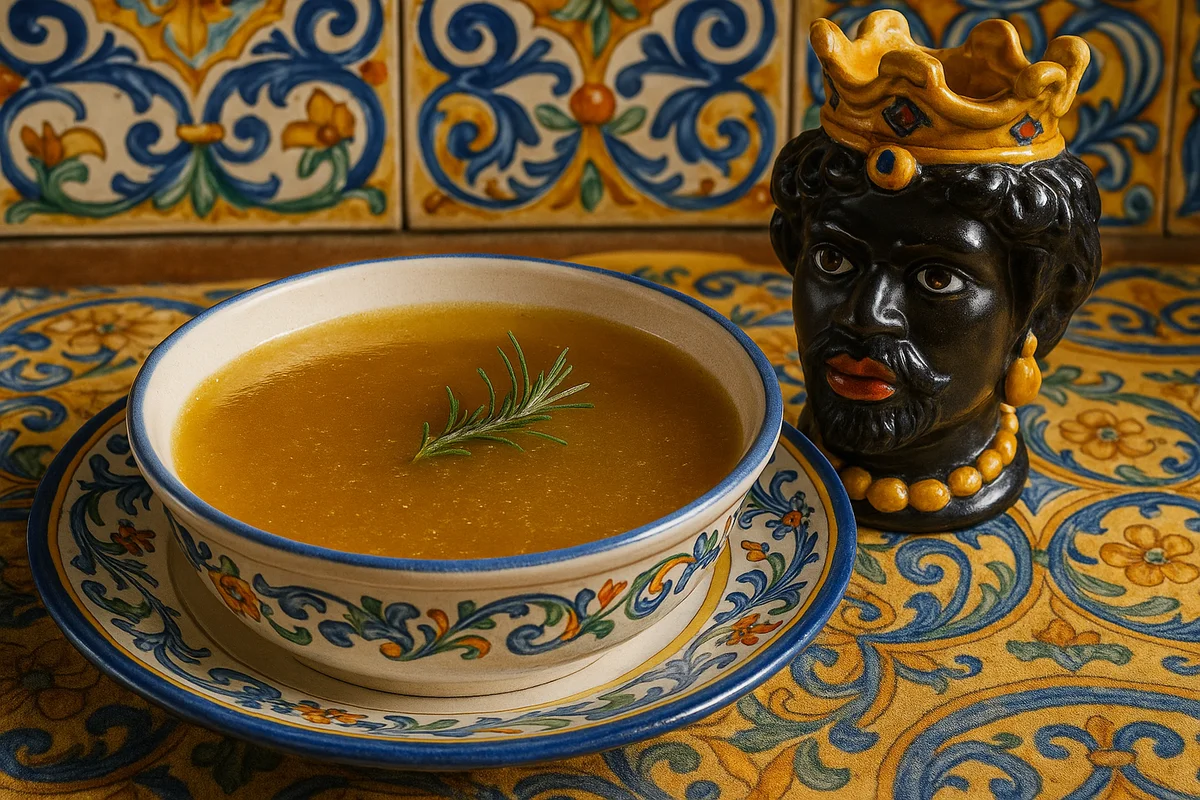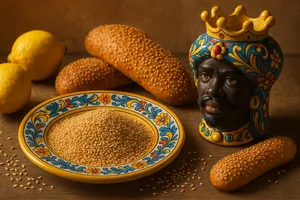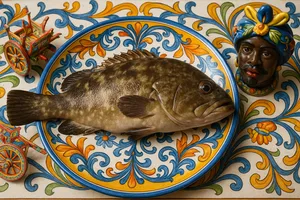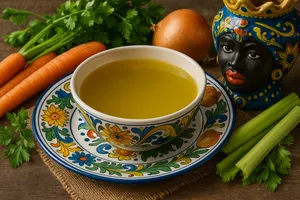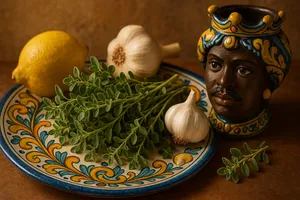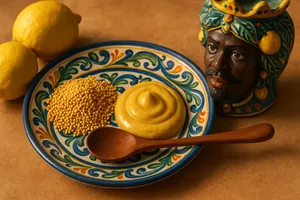Overview
Meat broth, known in Sicilian as “vrodu” or “broru,” is a foundational preparation in traditional island cuisine—a symbol of the culinary wisdom that transforms simple ingredients into the base of extraordinary dishes. This golden, aromatic liquid, obtained by slowly simmering meat and bones with vegetables and herbs, represents the essence of the most authentic and homely Sicilian cooking.
In Sicilian tradition, meat broth has long been considered not only an ingredient but a complete food in itself. It is served hot on cold days, used to cook pasta and rice, and forms the base of nourishing soups. Sicilian grandmothers prepared it with care, following recipes passed down through generations, knowing that a good broth is the key to many successful dishes.
Characteristics
A well-prepared meat broth appears clear or slightly cloudy, with a golden to deep amber colour depending on the meats used. Its aroma is intense and enveloping, with notes reminiscent of roasted meat, caramelised vegetables, and herbs.
The flavour is rich, deep, and complex, with perfect balance between the sweetness of vegetables and the savouriness from the meat and long cooking time. The texture should be silky on the palate—slightly full-bodied but never overly fatty. A good broth leaves a velvety mouthfeel and a pleasant, lingering aftertaste.
Traditional ingredients
In Sicilian tradition, meat broth is prepared with a mix of meats and bones that provide flavour, gelatine, and nutrients. The most commonly used meats are beef, veal, chicken, or hen—often combined for a more complex flavour.
Bones, especially marrow bones, are essential for giving body and natural gelatine to the broth. Classic vegetables include carrots, celery, onion, and tomato, while herbs typically include parsley, bay leaf, and sometimes cloves pinned into the onion.
The traditional ratio calls for about 1.5–2 kilograms of meat and bones for 3 litres of water, with one carrot, one celery stalk, one onion, and optionally a ripe tomato. Salt should always be added at the end of cooking to prevent the broth from becoming too salty as it reduces.
Traditional preparation
Preparing meat broth the Sicilian way requires time and patience. Meat and bones are placed in a large pot and covered with cold water. Starting with cold water allows the proteins to release gradually, producing a clearer and more flavourful broth.
The pot is slowly brought to a simmer, and the impurities that rise to the surface during the first 15–20 minutes are skimmed off. This step is essential for achieving a clear broth. Once skimmed, the heat is reduced to the lowest setting, and the washed, roughly cut vegetables and herbs are added.
The broth must simmer gently—never boil vigorously—for at least 3–4 hours. Some traditional recipes call for 6–8 hours for a more concentrated broth. Hot water is added as needed if the level drops too low. Salt is adjusted only toward the end.
When cooking is complete, the broth is strained through a fine sieve or a clean cloth. It is cooled completely, then the solidified fat layer on top is removed.
Culinary uses
In Sicilian cuisine, meat broth is used in numerous traditional preparations.
Soups and stews
It forms the base of classic soups such as “minestra maritata,” rich in vegetables, legumes, and pasta. It is used to cook tortellini (a festive dish also adopted in Sicily) and to prepare nourishing soups with pasta, rice, or grains.
Risottos
A proper Sicilian-style risotto is made using hot meat broth added one ladle at a time during cooking. This gives creaminess and depth of flavour that water or other liquids cannot provide.
Meat sauces and braises
Broth is used to enhance and extend meat sauces, braises, and stews. It keeps meats tender during cooking and enriches sauces with superior flavour.
Cooking stuffed pasta
Ravioli, anolini, and other stuffed pastas are traditionally cooked in meat broth, which enhances the flavour of the filling. This is typical of Sicilian festive meals.
As a dish on its own
Hot broth served with croutons or small pasta shapes is considered a complete, restorative dish, ideal for children, the elderly, and those recovering from illness.
Regional variations
Across Sicily, meat broth varies depending on the area and family traditions. In western Sicily, a piece of veal shank is often added to make the broth more gelatinous. In the eastern part of the island, chicken is preferred over beef for a more delicate broth.
In some mountain areas, a ham bone or piece of pork rind is added for extra richness. For festive preparations, especially at Christmas, broth is often made with capon, considered particularly fine.
Storage
Meat broth keeps in the refrigerator for 3–4 days in well-sealed glass or food-safe plastic containers. The fat layer that forms on top during cooling may be left in place until use, as it helps protect the broth from oxidation.
For longer storage, broth can be frozen in portions using suitable containers or freezer bags. It keeps for 3–4 months without losing quality. Freezing it in ice cube trays is useful for having small quantities on hand to add flavour to sauces.
Before using stored broth, bring it to a boil for a few minutes, whether refrigerated or thawed.
Nutritional properties
Meat broth is highly nutritious despite having a moderate calorie content (20–40 calories per 100 ml depending on concentration). It is rich in easily absorbed proteins, minerals such as iron, calcium, phosphorus, and magnesium, and essential amino acids.
It also contains collagen and gelatine from bones and cartilage, beneficial for joints, skin, and connective tissue. Slow cooking makes these nutrients highly bioavailable, which is why broth is traditionally considered a restorative food.
It is easily digestible, making it ideal for those with digestive difficulties, young children, and the elderly. In Sicilian folk medicine, it was viewed as a remedy for colds, weakness, and recovery.
Tips for perfect broth
For excellent broth, use high-quality meat and bones, preferably from traditionally raised animals. Combining different meats (beef, veal, chicken) increases flavour complexity.
Cooking temperature must always be low, with only a gentle simmer. A vigorous boil causes cloudiness and diminishes flavour. Skimming at the start is essential for clarity.
The pot should not be completely covered; leave a small gap for steam to escape. Vegetables should not be finely chopped or they will disintegrate during long cooking, clouding the broth.
For an even clearer broth, some Sicilian cooks “clarify” it by adding beaten egg whites to the hot, strained broth, bringing it back to a boil while stirring gently, then straining again. The coagulated egg whites trap impurities.
Curiosities
In Sicilian tradition, broth was often prepared on Sunday mornings as the family gathered for a festive lunch. The aroma of broth simmering for hours filled the house, a symbol of warmth and conviviality.
A Sicilian saying goes: “Cu’ havi bon vrodu, havi bona cucina” (“Whoever has good broth has good cooking”), emphasising its importance in achieving excellent dishes.
Marrow bones, called “ossi cannaruti” in Sicilian, were especially prized. The cooked marrow was often spread on toasted bread as a rustic and much-loved antipasto.
In folk belief, chicken broth had near-miraculous healing properties: it was thought to cure colds, fatigue, and general weakness. New mothers were given chicken broth to recover after childbirth and encourage lactation.
In some areas of Sicily, especially during patron saint festivals, large cauldrons of broth were prepared to feed pilgrims and the poor. This charitable custom, known as “a carità,” highlights broth as a complete, comforting, and communal food.

